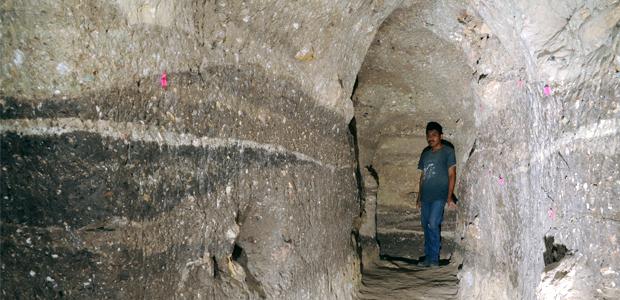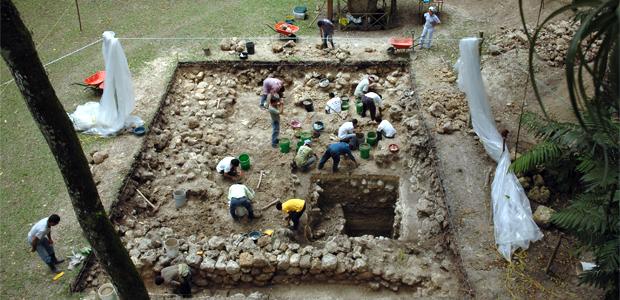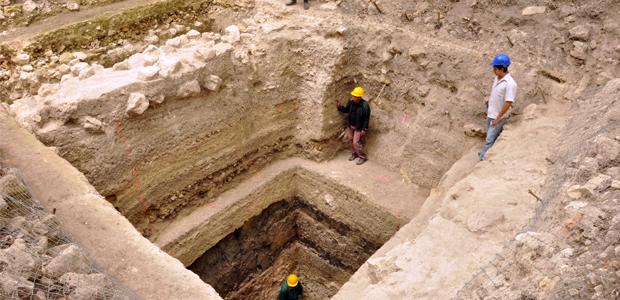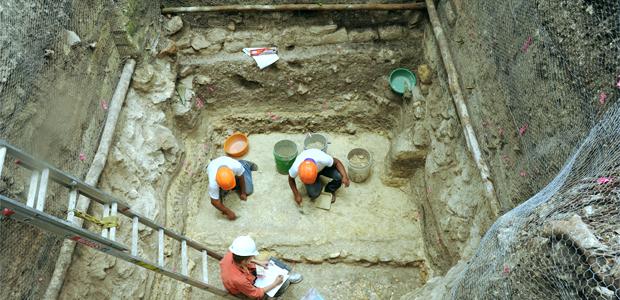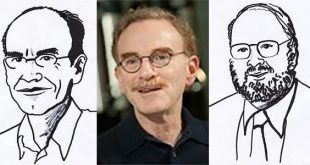A hand carved tunnel and other excavations at the settlement of Ceibal in Guatemala, have helped an international team of researchers identify the earliest ceremonial and monumental structures.
A hand carved tunnel that plunges 29 meters into the core of a Maya pyramid – that’s about as long as an NBA basketball court – and other excavations at the settlement of Ceibal in Guatemala, have helped an international team of researchers study some of the site’s first ceremonial structures.
Buried in places by nearly 20 meters of expansion and renovation, radiocarbon dates also make them part of the earliest ceremonial compound in the region by roughly 200 years – findings that may even help researchers dig into the roots of Maya culture.
“I noticed a similarity in the arrangement of buildings to those at the sites in Chiapas and at the Olmec site of La Venta,” Takeshi Inomata, study co-author and professor of anthropology at the University of Arizona, told SciFare.com. “We thought that patterns in the map reflected early patterns of interaction that happened at the beginning of Maya civilization.”
The earliest structures in the ceremonial compound were built by Ceibal’s first residents – they also built the oldest monument in the Maya lowlands and other important structures – around 1,000 BC.
Before there were pyramids – they’re really more like mounds of earth – researchers said a pair of platforms flanked a centralized limestone plaza.
“It’s a setting for communal rituals and the platforms are something like a performance stage,” Inomata said. “The rituals are mainly communal in this early period – people gathered together and then celebrated the ritual together.”
On its west side, the tunnel revealed a foundation carved from the decaying limestone bedrock – it’s technically known as marl – before it was built up to a height of two metres with black soil, clay and capped with a white floor.
Over the next century it would be filled and expanded before the first pyramid was erected sometime between 850 and 800 BC – by 700 BC, the pyramid would grow to as much as eight metres tall – and researchers said the structure underwent at least 11 different renovations.
“Pyramids are much more restricted places,” Inomata said. “Only a few people, probably, could go up to the top of the building.”
Eventually, they’d be controlled by the royal families and even became their final resting places.
On the plaza’s east side, the researchers uncovered a rectangular stage that was at least 40 metres long – it could have been as much as 55 metres from end-to-end though. By 700 BC, the limestone carved platform would be filled in and rebuilt a little further east, so the plaza could be expanded.
“This formalized pattern appears over and over again at various sites,” Inomata said. “That means the first people shared a common idea of how the ceremonial centre should look and how the rituals should go.”
They would eventually evolve into complexes that contained towering pyramids and sprawling plazas that still dot sites in the Maya lowlands.
Artifacts recovered from the excavations tell their own unique and important story too – the ceramics, for example, provided researchers with the framework necessary to sync the radiocarbon dates with the layers of soil that have preserved them.
“The emergence of ceramics was part of a very large social change,” Inomata said. “At the beginning, there were different people interacting in a very complex and diverse way.”
As we know them, the Maya culture was very young still – before 1,000 BC, they were still a bunch of fragmented groups.
“Later in time we’re seeing the emergence of a more unified Maya culture that’s reflected in the ceramics,” he added.
Many changes like that mark the beginning of the Middle Preclassic time period in Maya history – the ceremonial compound is just one of the new ideas popping up.
“There’s a unique process happening at Ceibal that’s different from the rest of the Maya area,” Inomata said.
A re-analysis of isotope data from one of Ceibal’s early residents also found that freshwater stock like shellfish, at most, accounted for ten per cent of their diet.
“From that point, people started to rely more heavily on maize production and then their agriculture and settlement patterns possibly changed,” Inomata said.
The fragmented Mayan groups would start coming together in the Maya lowlands, they’d abandon their mobile way of life and would eventually become the Maya civilization.
“Once maize became productive, the Maya lowlands became an important area that could support a larger population and civilization,” Inomata said.
The researchers said that political conditions were also right for Ceibal’s rise – it was an interesting time in Mesoamerican history. Before it existed, the Olmec power-centre was a site called San Lorenzo – for a time, it was the largest too.
They may have carved colossal heads out of stone there, but, the site didn’t have a ceremonial compound – known technically as an E-Group assemblage. The researchers said it started to decline about 150 years before Ceibal sprung up.
La Venta would eventually replace San Lorenzo and had a ceremonial compound. After re-analyzing radiocarbon dates obtained by another research team, they found Ceibal was thriving for about 200 years before La Venta was even large enough to exert its influence on them.
“There’s this period of about 300 years or so where we don’t have very dominant Olmec centres,” Inomata said. “In this power vacuum, the different groups started to interact more freely, more intensively and then they started to experiment with various new ideas.”
That complicates things because theories about the roots of the Maya civilization focus on whether or not the Olmec people played a role in shaping them – ‘it’s complicated’ isn’t even an option.
“We need to see how those smaller units of people interacted,” Inomata said. “Major renovations took place, not in the political centres, but through the interactions of relatively small groups of people, across potential cultural boundaries.”
The research was published in the journal, Science.
Follow Lee Flohr or SciFare.com on Twitter and don’t forget to like our Facebook page
 Science Fare Media Science News – Upgraded
Science Fare Media Science News – Upgraded
